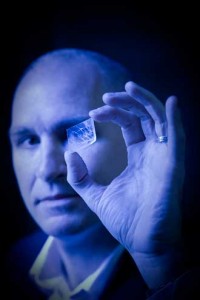
Researcher passionate about the crystals and proteins that make up our bones
By Mark Shainblum
Dr. Marc McKee has a unique, almost biblical view of the human body. Like Lot’s Wife, he says, we’re already – in our bones and teeth – partially made of stone. Moreover, under the right circumstances, even soft tissue like skin can be transformed into stone.
The Associate Dean (Research) at the Faculty of Dentistry, and also a member of the Dept. of Anatomy and Cell Biology, McKee is an expert on biomineralization, the process by which living organisms produce rigid, mineral-based tissue like bone, teeth and shells. Most human tissue is made up of fibres of soft proteins, he explains, largely collagen, the most abundant extracellular protein in mammals.
“The primary distinction between a soft tissue like skin and hard tissue like bone is that bone cells make additional proteins that are pumped into this meshwork,” McKee said. “This triggers and guides the process of mineralization, as billions of nanocrystals of calcium and phosphate precipitate within and around those collagen fibrils, forming the mineralized bone matrix.
“Size aside, there are few differences between these crystals impregnating your bones, and a rock made of hydroxyapatite crystal you find lying on the ground during a hike,” he said.
McKee became fascinated by biomineralizaton as an undergraduate in McGill’s anatomy and cell biology program.
“I wanted to do something in the life sciences, but I didn’t know what,” he said. “In my final undergraduate year I took a course on bones and teeth taught by Dr. Hershey Warshawsky. He was a terrific teacher and really sold me on the subject. When he asked if I was interested in doing a PhD with him, I had already been accepted to dental schools. I was at a fork in the road: do I go the clinical professional or academic researcher route? Not many people turn down dental school, but I decided that the research track was for me.”
If biomineralization research seems a trifle esoteric and – dare we say it? – even a little boring when compared to high-profile fields like oncology and genomics, McKee’s passion for the field immediately convinces you otherwise. The formation of bones and teeth are critical to human existence, he explains. In birds and some other animals, the very continuance of the species is dependent on biomineralized eggshells made of calcium drawn directly from the mother’s bones. Clearly still fascinated by his chosen field, McKee is also passionate about the potential clinical breakthroughs he and his colleagues are pursuing.
Diseases with biomineralization defects include osteogenesis and dentinogenesis imperfecta, genetic disorders where the collagen fibrils do not form properly, leading to brittle bones, and the various forms of osteomalacia, including rickets, which lead to abnormally soft bones and symptoms like extreme bowleggedness or knock-knees.
Perhaps even worse are the rare but terrible diseases that cause normal tissue to calcify unnaturally, McKee says, calling up a medical archive photo of a patient on his laptop and pointing at the chest.
“Everything is mineralizing in this man’s body. His bones are fusing together at the ribs, his neck is entirely fused. He eventually died of pneumonia because he couldn’t breathe, because his ribs simply weren’t moving.
“Kidneys (with kidney stones), blood vessels (atherosclerosis) and the surface of teeth (calculus/tartar) all can have mineral crystals forming where they’re not supposed to,” he said. “In calciphylaxis of the skin, skin calcifies and literally rips apart, causing ulcers rupturing at the surface of the skin. In many heart patients, the coronary arteries calcify, and little fragments of these regions can break off into the bloodstream and cause heart attacks and stroke.”
McKee and his research team study how proteins like osteopontin control the growth of nanocrystals within the bone matrix, and the dire repurcussions that can occur when the process goes wrong.
“Crystals have surfaces that are shaped like an escalator in the Metro, they have little steps,” he explained. “The crystals grow when calcium phosphate unit cells are continuously added like little boxes on these steps. The proteins we study bind to those steps to control crystal growth. Imagine jamming a wrench into the escalator mechanism and freezing it. It’s a very finely regulated process and we’re starting to understand how it works.”
